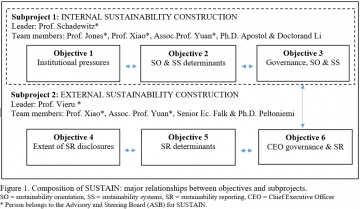Research objective and design
Research objective
The overall research objective is to analyse sustainability construction in two categories of firms: firms with a low sustainability profile and firms with a high sustainability profile in two China and Finland. The sizes, strategies, industries and income generation processes of firms differ. Thus, for matching purposes, we will focus on industries that have, according to prior research and anecdotal evidence, high environmental impacts: basic materials, industrials, and consumer goods.
Insight into sustainability construction will come from two diverse institutional settings, and we will explore the relationship between them.
First (the internal perspective), we will focus on how companies exhibit sustainability orientation and utilise sustainability systems in Finland and China. Finland is a northern EU member with just over 5 million inhabitants; China is the world’s second largest economy and a transition economy – moving away from a planned economy to a market-oriented one. These two countries provide excellent contrasts for exploring sustainability issues. Finland has been at the forefront of sustainability reporting since concerns about sustainability arose. China has only recently become involved in sustainability. Thus, we have the possibility to compare sustainability construction for firms operating in a country with a good sustainability reputation with those in an emerging sustainability reputation country. Those highly different business environments should provide new insights into firms’ sustainability orientation, sustainability systems and sustainability reporting, enabling us to identify the influence of institutional and firm-specific factors that jointly occur in firm sustainability construction.
Second, the external perspective complements the internal perspective; combining the two perspectives will be unique in sustainability literature and offer a comprehensive, value adding, analysis of sustainability dimensions in business organisations. The external perspective analyses the extent and determinants of sustainability reporting in Finland and China. Although extant research has attempted to identify important differences between sustainability orientation and sustainability reporting in different countries and regions, such research is scarce and typically focused on either sustainability orientation or sustainability reporting, failing to systematically cover both dimensions. Research indicates that sustainability reporting alone, without an appropriate incorporation of sustainability in corporate strategies and operations, can lead to Green-washing, i.e. discrepancies between internal actions and external reporting. Thus, researching sustaiability reporting needs to be linked to a firm’s underlying sustainability orientation and sustainability systems.

All in all, the available research lacks a holistic understanding across sustainability orientation, sustainability systems and sustainability reporting. SUSTAIN will thus cover the whole sustainability construction chain from firms’ sustainability orientation via relevant sustainability systems to sustainability reporting. Recognising and capturing the whole sustainability theme is fundamental to explaining quantifiable realisations of sustainability, such as reporting quality in sustainabilility reports.